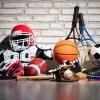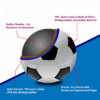The Importance of Choosing the Right Sports Equipment
The right sports equipment can significantly impact your performance and safety on the field or court. Proper gear increases comfort, reduces the risk of injury, and helps you play more effectively. Whether you’re a beginner or an experienced athlete, using equipment suited to your level and body type can improve your skills and stamina.
In addition, using the right sports equipment can prevent long-term health problems. For example, wearing the right type of shoes for running can protect your joints and prevent common injuries like shin splints or plantar fasciitis. Similarly, using a racket designed for your playing style in tennis can prevent wrist or elbow strains. This makes choosing the right gear an important step in any athletic journey, no matter the sport.
2. Know your sport: What equipment is needed?
Each sport comes with its own set of essential equipment. Start by making a list of what you need for your sport. Understanding what purpose each piece of equipment is designed for helps you decide which products you should invest in. Here’s an overview of common sports and their essential gear:
- Basketball: shoes, ball, hoop and protective gear.
- Football/soccer: cleats, shin guards and ball.
- Tennis: rackets, shoes and appropriate clothing.
- Running: running shoes, water bottles and sportswear.
3. Assess your skill level
Your level of experience greatly affects what kind of equipment you should use. A beginner’s needs are different from those of a professional. Here’s how to differentiate between the two:
- Beginner: Look for equipment that is versatile, affordable, and easy to use. If you’re just starting out, your primary goal should be to learn the basics. You don’t need top-tier gear right away—entry-level items will usually suffice until your skills improve.
- Intermediate: At this level, you should focus on more sport-specific equipment that can help improve your performance. Intermediate gear often includes additional features that enhance your ability, such as more durable materials or advanced technology.
- Professional: High-quality, sport-specific equipment designed for optimal performance and durability. Pros require gear that meets strict performance standards, often focusing on precision, customization, and advanced ergonomics.
4. Consider fit and comfort
No matter the sport, the fit and comfort of your gear should be a top priority. Ill-fitting shoes, clothing or protective gear can hinder your movement and increase your risk of injury. For example, shoes that are too tight can cause blisters and other foot problems, while ill-fitting helmets or pads offer less protection in contact sports. Here are some things to consider:
- Shoes: Always try shoes on and walk or run in them to check comfort. Consider factors such as arch support, toe space and ankle stability.
- Apparel: Choose moisture-wicking, breathable fabrics to stay cool and dry. Well-fitted clothing allows for better movement and can help regulate body temperature.
- Protective gear: Helmets, pads or guards should fit well to provide maximum protection without hindering movement. Make sure protective gear meets the relevant safety standards for your sport.
5. Materials and Durability
When choosing the right sports equipment, you should also consider the material and its durability. Quality equipment may come with a higher price tag, but offer better performance and longevity. The last thing you want is for your gear to wear out quickly, leading to frequent replacements and increasing costs over time. Some materials to look out for include:
- Leather: For durability in balls, gloves, and shoes. Leather is often preferred for its strength and flexibility, especially in sports like boxing or baseball.
- Synthetic fabrics: For lightweight, moisture-wicking sports. These fabrics dry faster and are typically more breathable, which is important in high-intensity sports.
- Carbon fiber or aluminum: Used in high-performance sports gear like tennis rackets or bicycles. These materials are lightweight but strong, providing durability without compromising performance.
6. Safety Features: A Must for Every Athlete
Safety should always be your top priority. Many sports injuries are caused by inadequate or faulty equipment. Here’s how to avoid them:
- Helmet and pads: Check for safety certifications such as ASTM or NOCSAE standards for helmets and padding.
- Eyewear: In sports such as basketball or racquetball, wear protective goggles to protect your eyes. Properly fitting eyewear ensures visibility and comfort while protecting against injury.
- Footwear: Shoes with proper arch and ankle support prevent common injuries such as sprains.
7. Budget Considerations: Finding the Right Balance
It’s easy to get overwhelmed by expensive, high-end sports gear, but more expensive isn’t always better. Here’s how to strike a balance between quality and affordability:
- Beginner: Start with affordable equipment and upgrade as you get better.
- Intermediate: Look for mid-range products that offer advanced features at a reasonable price.
- Professional: Consider investing in premium gear, as the benefits of high-end performance outweigh the cost.
8. Brand reputation and reviews
The brand you choose can also have an impact on the quality and performance of the sports equipment you buy. Research well-known brands and read customer reviews to make an informed decision. Trusted brands often offer warranties and customer support, giving you peace of mind. Some established sports equipment manufacturers also have affiliations with professional athletes, meaning their gear has been rigorously tested in the field.
9. Test before you buy
Whenever possible, try out sports equipment before you buy. Whether trying on shoes, swinging a racket or handling a ball, feeling the gear helps ensure it’s right for you. Many sports stores allow trial sessions or offer flexible return policies.
10. Maintenance and Care for Longevity
Once you’ve chosen the right sports equipment, proper maintenance is the key to ensuring its longevity. Clean your gear regularly, store it in proper condition, and replace worn-out items promptly.




